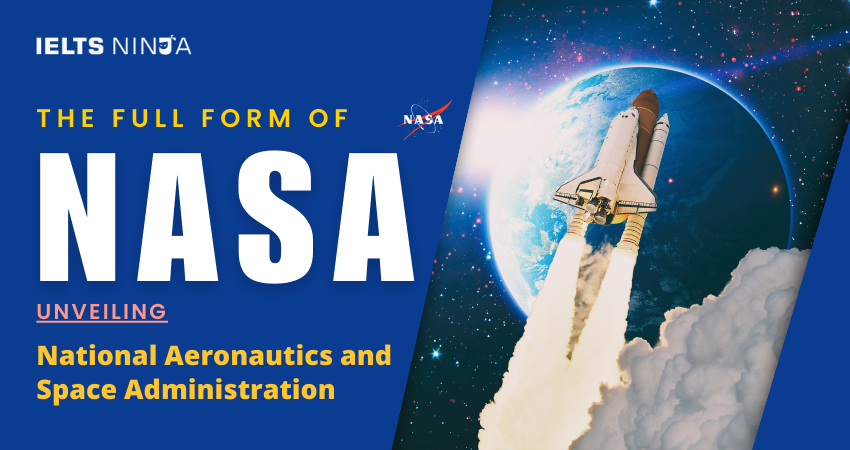In the realm of space exploration and aeronautics, “NASA” is an iconic abbreviation that needs no introduction. The full form of NASA, which stands for the National Aeronautics and Space Administration, is the United States government agency responsible for the nation’s civilian space program and for aeronautics and aerospace research. In this comprehensive guide, we will explore the details of NASA, its mission, and its significant contributions to space exploration and scientific research.
What is NASA?
NASA is a prominent federal agency established on July 29, 1958, as a response to the Soviet Union’s launch of the first artificial satellite, Sputnik. It was founded with the primary goal of leading the nation’s efforts in space exploration, scientific discovery, and aeronautics research. NASA’s work extends beyond Earth’s atmosphere, delving into the mysteries of the cosmos and advancing technology for both space and Earth applications.
NASA’s Mission
NASA’s mission is summarized in three primary objectives:
- Exploration: NASA explores space and conducts missions to understand our universe, from studying planets and celestial bodies within our solar system to investigating distant galaxies.
- Scientific Discovery: NASA conducts cutting-edge research and scientific experiments to expand our knowledge of space, Earth, and the universe, addressing critical questions about our existence and the cosmos.
- Aeronautics Research: NASA advances aeronautics and aviation technology to enhance the safety and efficiency of air travel and promote sustainable aviation.
NASA’s Key Achievements and Milestones
NASA has achieved numerous significant milestones and contributions to space exploration and scientific research, including:
Apollo Moon Missions:
NASA’s Apollo program achieved the historic Apollo 11 mission, where astronauts Neil Armstrong and Buzz Aldrin became the first humans to walk on the Moon in 1969.
Space Shuttle Program:
The Space Shuttle program, which operated from 1981 to 2011, facilitated numerous missions to deploy satellites, conduct experiments, and build the International Space Station (ISS).
International Space Station (ISS):
NASA played a pivotal role in the development and operation of the ISS, a symbol of international collaboration in space research and exploration.
Mars Rovers:
NASA’s Mars rovers, including Spirit, Opportunity, Curiosity, and Perseverance, have conducted extensive studies of the Martian surface and provided insights into the planet’s history and potential habitability.
Hubble Space Telescope:
NASA’s Hubble Space Telescope has captured breathtaking images of distant galaxies, stars, and nebulae while revolutionizing our understanding of the universe.
Voyager Probes:
The Voyager 1 and Voyager 2 spacecraft, launched in the 1970s, continue to send data from the outer reaches of the solar system, offering insights into interstellar space.
Exoplanet Discoveries:
NASA’s Kepler and TESS missions have identified thousands of exoplanets beyond our solar system, expanding our understanding of potentially habitable worlds.
Climate Research:
NASA’s Earth Science Division conducts vital research on climate change, monitoring Earth’s climate and providing essential data for policymakers and scientists.
यह भी पढ़ें: सर्वश्रेष्ठ ऑनलाइन आईईएलटीएस कोचिंग एवं प्रशिक्षण अकादमी
International Collaboration – NASA
NASA collaborates extensively with international space agencies, including the European Space Agency (ESA), the Russian space agency Roscosmos, and others. These collaborations strengthen the collective efforts in space exploration and foster diplomatic and scientific cooperation on a global scale.
Challenges and Future Goals – NASA
NASA faces various challenges, including budget constraints and the need to ensure the safety of astronauts during space missions. However, the agency remains committed to its ambitious goals, including:
- Artemis Program: NASA’s Artemis program aims to return humans to the Moon and establish a sustainable lunar presence, with the goal of sending the first woman and the next man to the lunar surface.
- Mars Exploration: NASA continues its efforts to send humans to Mars, with plans for future crewed missions to the Red Planet.
- Climate Research: NASA’s Earth science missions contribute to understanding and addressing climate change, an increasingly critical global issue.
निष्कर्ष
NASA, the National Aeronautics and Space Administration, stands as a beacon of human achievement and scientific exploration. For decades, it has pushed the boundaries of space exploration, expanded our understanding of the universe, and driven technological advancements that benefit both space and Earth. As NASA continues to reach for the stars, its mission of exploration, discovery, and innovation remains an inspiration to generations and a testament to the power of human curiosity and ingenuity.








